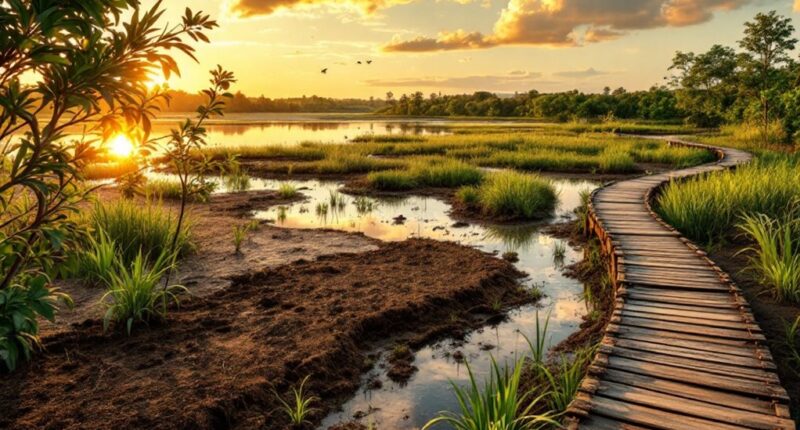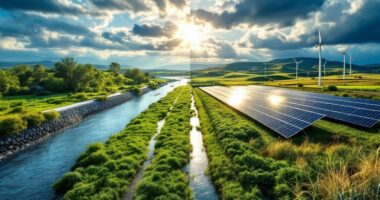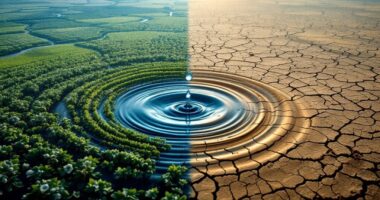Habitat restoration techniques rebuild damaged ecosystems through strategic interventions. Revegetation with native species forms the backbone, while nurse plants shelter vulnerable seedlings. Mycorrhizal networks enhance soil health, working alongside invasive species removal efforts. Soil remediation brings life back to degraded earth through phytoremediation and biochar applications. Water flow restoration and wildlife reintroduction complete the picture, reconnecting fragmented landscapes. These interwoven approaches transform ecological wastelands into thriving, self-sustaining communities once again.

The art of healing wounded landscapes has evolved into a sophisticated science, with habitat restoration techniques now forming the backbone of conservation efforts worldwide. Like environmental physicians, restoration ecologists diagnose ecosystem ailments and prescribe tailored treatments that range from simple interventions to complex, multi-year recovery plans.
Nature’s doctors heal broken landscapes, applying ecological medicine with surgical precision to restore Earth’s vital systems.
Revegetation stands as perhaps the most visible restoration strategy. Practitioners don’t just scatter seeds and hope for the best—they carefully select native species, employ nurse plants as living umbrellas for sensitive seedlings, and even recruit fungal allies. Mycorrhizal fungi form underground networks that fundamentally turn the soil into a social network where resources are shared.
Before new life can flourish, invasive species—the botanical bullies of the ecosystem—must be addressed. Removal techniques range from the straightforward (hand-pulling stubborn weeds) to the sophisticated (introducing natural predators that target only the unwanted guests). These approaches often work in concert, like different instruments in an ecological orchestra. Tussac grass planting has proven especially effective for stabilizing eroded soils and creating new wildlife habitats in degraded coastal areas.
The foundation of any ecosystem is literally underfoot—soil. Remediation efforts might involve adding organic matter (nature’s vitamin supplement), using plants to extract contaminants (phytoremediation), or deploying microorganisms that treat pollutants like an all-you-can-eat buffet. Biochar, a form of charcoal, serves as both apartment complex for beneficial microbes and long-term carbon storage solution. Assisted natural regeneration can be remarkably cost-effective, requiring only about one-fifth of the expenses associated with traditional reintroduction efforts. Restoration experts regularly employ species diversity assessments to measure ecosystem recovery and ensure that habitat complexity is returning to damaged areas.
Water flow restoration—removing dams, reconnecting floodplains, or crafting wetlands—acts like reopening circulation in an ecosystem’s bloodstream. Meanwhile, reintroducing wildlife completes the picture, with approaches ranging from captive breeding programs to creating wildlife highways that connect fragmented habitats.
Throughout this process, monitoring serves as the essential feedback loop. Using everything from satellite imagery to citizen science volunteers armed with smartphones, restoration teams track their progress and adapt strategies accordingly. This scientific vigilance transforms restoration from a one-time intervention into an ongoing conversation with nature—a dialogue that helps damaged ecosystems find their voice again.
Frequently Asked Questions
How Long Does Habitat Restoration Typically Take to Show Results?
Habitat restoration typically shows initial positive results within 3-5 years, with biodiversity increasing by about 20% on average during this establishment phase. However, full ecosystem recovery is a marathon, not a sprint—complete restoration may take over 20 years.
The timeline varies based on factors like weed pressure, weather conditions, starting conditions, and planting methods. Even after decades, restored sites often remain about 13% below reference biodiversity levels.
What Are the Costs Associated With Different Restoration Techniques?
Restoration costs vary dramatically by ecosystem type and technique.
Wetlands typically run $80,000 per hectare (median), while coral reef projects can create up to 30 jobs per $1 million invested. Riparian restoration includes fencing ($1.50-$3 per linear foot) and planting ($5,000-$135,000 per acre).
Costs generally decrease with larger project size, are lower in developing countries, and depend remarkably on ecosystem type—with coral reefs and seagrass being the most expensive to restore.
Can Extinct Species Be Reintroduced Through Habitat Restoration?
Extinct species cannot be directly reintroduced through habitat restoration alone. While restoration creates suitable environments, truly extinct species require genetic approaches like de-extinction or selective breeding. Projects like the Passenger Pigeon revival and Quagga Project demonstrate this combination approach.
For locally extirpated species (extinct in a region but existing elsewhere), habitat restoration can facilitate successful reintroductions, as seen with Eurasian beavers in the UK and grey wolves in Yellowstone.
How Do Climate Change Impacts Affect Restoration Planning?
Climate change fundamentally reshapes restoration planning by introducing moving targets. Practitioners now must consider species shifting northward (3.8 miles per decade on land, 17+ miles in oceans) and anticipate that half the planet will experience different climates by 2050.
Modern approaches emphasize genetic diversity, strategic site selection, and building connectivity through wildlife corridors. This climate-informed restoration delivers dual benefits: functional ecosystems and practical services like $23 billion in coastal protection from restored wetlands.
Who Should Be Involved in Community-Based Restoration Projects?
Effective community-based restoration projects require diverse stakeholders working in concert. Local residents provide on-the-ground knowledge and volunteer power, while indigenous communities contribute valuable traditional ecological wisdom.
Scientific experts bring technical expertise to guarantee ecological soundness. Government officials facilitate regulatory compliance, while non-profit organizations offer specialized experience. Including local businesses, youth groups, and educational institutions creates a robust network that balances community engagement with scientific rigor—turning restoration into a truly collaborative endeavor with multi-faceted benefits.









